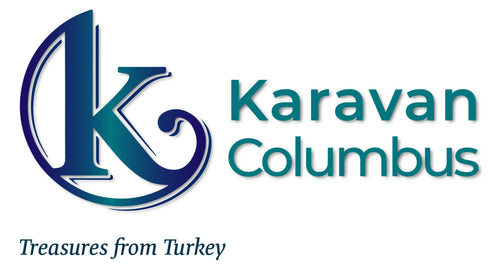


Sheep grazing in the out skirts of Hasan Dag. These are the sheep wool gathered from. Arabic Wool.



Konya Wool Tamer is holding our raw wool Stack of raw wool



Sheered good wool Good wool left, low grade wool right Shepherd's dog called "Karabash"



Wool is dyed with natural ingredients in this pool. Wool dying rack built by Suat's uncle. Walnut skin for shade of natural brown.






Cumin Straws for Cream color. Used for Cream and Browns. Different tones for Cream and Brown



Cumin Naturally dyed wool for Hereke colors. Naturally dyed wool for Shirvan Rugs.



We are entering the mountain weavingvillage. Women are weaving our rugs with natural materials.



Partially woven Rug Getting ready to wash. Ali is washing the rug after it was woven



Dinner Time, Selcuk minaret, Capadocia style rock formations where people used to live in the ancient times.
Weaving authentic hand-knotted rugs is not an easy task. There are many stages involved starting with wool. Let me list them for you. Among the nomadic background traditions, such as in Turkey and Central Asia, this is how it goes:
First the wool is either sheared in the fall or in the spring. The wool that is sheared in the fall is more broken and dirtier than the wool that was sheared in the spring, because of the cleanliness of the nature in the spring, the wool is shinier and has longer strands (elyaf) than the fall shear.



Sheep being grazed in the winter. They will be sheered in the spring. Second picture is the fall shear, which has shorter strands and dirtier look to it and it is harder to hand-spun the wool. Third picture is the spring shearing. As you can see, it is much cleaner and lush looking. The strand of wool is longer and stronger which makes it easier to spin, especially by hand.



This gentleman is getting the wool ready to be sent to be hand-spun in villages. This way, he can keep record who has what.
An elderly lady is spinning wool which will be used to make rugs, like the one she is sitting on, or pillows like the ones behind her.
This is one of the villages that we help people earn livings. This is what they do in the winter in these mountain villages.



Third stage is to wash the wool and dye it. This is a very heavy work and it is done by men in Turkey. Wool dying requires a lot of lifting and washing before and after. It is the same with washing the rugs after they are finished. Since the wool is all naturally dyed with natural ingredients, it needs careful timing, mixing the right amount of ingredient with the right amount of wool and so on. At the end, every batch of wool that is dyed is going to have slightly different look due to the process, which makes every carpet that is woven in this way unique like the ones we make at Karavan, Treasures from Turkey.
We have a dye pool which is heated from beneath. By using these long poles, wool can be lowered down or lifted up to see if it is ready to be taken out. As one could imagine, soaks all that water and becomes very heavy, not to mentioned the heat. That is why wool is cooled of so that it can be drained of water and put out to dry.



Now my people on the way to a village to deliver the materials for rug weaving. She is one of the master weavers in this village. She knows how to do the whole process. Should you look carefully, you could see the design on the loom. Girls are playfully weaving in their own environment.



Going through the whole finished rug after weaving to see anything was missed.
These weavers are using their living room for the final touches.
Everybody helps before the rug is taken to be washed.
Now the rug has to be washed and dryed before it is prepared to be shipped to the market place to find the luck buyer (like at Karavan, Treasures from Turkey).



Washing also takes a lot of heavy manual work that is why it is always man who do it. It is a good way of sharing different stages of work.
In the winter, carpets are dried in covered places. Since there is no gas heat in these places, electiricity or cast iron stoves are used.
This is the final check after washing the rugs and fringes are adjusted (shortened).
